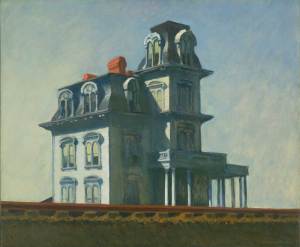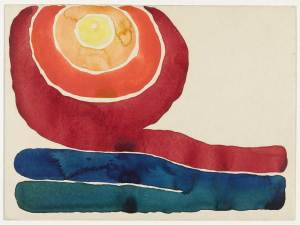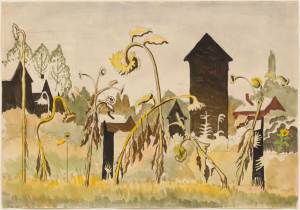With ‘American Modern: Hopper to O’Keeffe’, the Museum of Modern Art (MoMA) in New York squares up to what its founding director Alfred H. Barr was already calling ‘The Problem of Our American Collection’ back in 1933.

House by the Railroad (1925), Edward Hopper. Digital Image © The Museum of Modern Art, New York, Digital Imaging Studio
The ‘problem’ lies in the common perception that for art made before 1950 MoMA’s attention is decisively turned towards Europe – towards Picasso, Matisse, or Duchamp (the latter happily claimed by the gallery labels as ‘American, born France’, even though he didn’t become a US citizen until he was almost 70). American art, in this view, only becomes truly acceptable to MoMA with Abstract Expressionism, a fully-fledged modernist movement with critics and large philosophical ambitions of its own.
In any case, MoMA could hardly hope to compete in representing earlier 20th-century US painting with the Whitney Museum of American Art, founded just a year later, whose entire purpose and acquisitions budget was dedicated to the work of domestic artists. Keeping this rivalry up, ‘American Modern’ runs at the same time as the Whitney’s ‘American Legends: From Calder to O’Keeffe’, with which it significantly overlaps, and also with the Whitney’s ‘Hopper Drawing’, which closed just last week.

Evening Star, No. III (1917), Georgia O’Keeffe © 2012 The Georgia O’Keeffe Foundation / Artists Rights Society (ARS), New York Digital Image © The Museum of Modern Art, New York, Digital Imaging Studio
So how does ‘American Modern’ deal with this ‘problem’? First it tries to show that it might be less of a problem than people have thought. The exhibition is drawn entirely from the museum’s permanent collections, and many of the works included have rarely been on display; to gather them all into a few rooms makes the strength of MoMA’s holdings clear.
Here the exhibition succeeds abundantly. Hopper is represented by three oil paintings and a watercolour, Mrs Acorn’s Parlour (1926), which transcribes unflinchingly the over-cluttered cosiness of an interior which seems to be nursing a hangover from middle-class Victoriana. There are also some of his etchings, which seem to me less distinguished. We get a generous handful of O’Keeffe paintings and drawings, including Farmhouse Window and Door (1929), tucked away around a corner on its own – a hyperrealist depiction of the flattened planes of a shuttered window, so tightly cropped that it starts to seem abstractly geometric. The same effect is deployed in Charles Sheeler’s photograph Bucks County Barn (1932), and as well as photographs Sheeler is represented by crayon and pencil drawings, paintings in oil and gouache, and a lithograph, all faithfully attentive to the quiet and companionable being of objects and buildings.

Rogue’s Gallery (1916), Charles Burchfield. Reproduced with permission of the Charles E. Burchfield Foundation
Among the 50-odd artists whose work is on display, other highlights are the excerpts from Jacob Lawrence’s Migration Series (1940-41), the paintings by Stuart Davis, with their proto-Pop appropriation of commercial imagery, the watercolours by Charles Burchfield of drooping sunflowers or haunting woods, and the photographs by Walker Evans, Alfred Stieglitz, Ansel Adams, and Edward Weston.
The various and miscellaneous nature of these works points to the difficulty of the second thing this exhibition wants to do, which is to say something about the dialogue on the ‘Americanness’ of American art which dominated the period in which these works were made. The catalogue essay treads cautiously; a footnote wonders whether it’s even too much to use the word ‘American’ to name work made in the United States, ‘given the rich cultural production of South America’.
Some of these works are intensely in debate with European modernism while others call up folk-art precedents; some are social-realist, while others draw from illustration or commercial art, or move towards abstraction; some are concerned with distinctively American spaces (Manhattan, the Great Plains), while others could come from anywhere in the world. We might recall Leopold Bloom’s pragmatic definition in Joyce’s Ulysses: ‘A nation? A nation is the same people living in the same place… Or also living in different places’.
‘American Modern: Hopper to O’Keeffe’ is at MoMA, New York, until 26 January 2014

All American
House by the Railroad (1925), Edward Hopper. Digital Image © The Museum of Modern Art, New York, Digital Imaging Studio
Share
With ‘American Modern: Hopper to O’Keeffe’, the Museum of Modern Art (MoMA) in New York squares up to what its founding director Alfred H. Barr was already calling ‘The Problem of Our American Collection’ back in 1933.
House by the Railroad (1925), Edward Hopper. Digital Image © The Museum of Modern Art, New York, Digital Imaging Studio
The ‘problem’ lies in the common perception that for art made before 1950 MoMA’s attention is decisively turned towards Europe – towards Picasso, Matisse, or Duchamp (the latter happily claimed by the gallery labels as ‘American, born France’, even though he didn’t become a US citizen until he was almost 70). American art, in this view, only becomes truly acceptable to MoMA with Abstract Expressionism, a fully-fledged modernist movement with critics and large philosophical ambitions of its own.
In any case, MoMA could hardly hope to compete in representing earlier 20th-century US painting with the Whitney Museum of American Art, founded just a year later, whose entire purpose and acquisitions budget was dedicated to the work of domestic artists. Keeping this rivalry up, ‘American Modern’ runs at the same time as the Whitney’s ‘American Legends: From Calder to O’Keeffe’, with which it significantly overlaps, and also with the Whitney’s ‘Hopper Drawing’, which closed just last week.
Evening Star, No. III (1917), Georgia O’Keeffe © 2012 The Georgia O’Keeffe Foundation / Artists Rights Society (ARS), New York Digital Image © The Museum of Modern Art, New York, Digital Imaging Studio
So how does ‘American Modern’ deal with this ‘problem’? First it tries to show that it might be less of a problem than people have thought. The exhibition is drawn entirely from the museum’s permanent collections, and many of the works included have rarely been on display; to gather them all into a few rooms makes the strength of MoMA’s holdings clear.
Here the exhibition succeeds abundantly. Hopper is represented by three oil paintings and a watercolour, Mrs Acorn’s Parlour (1926), which transcribes unflinchingly the over-cluttered cosiness of an interior which seems to be nursing a hangover from middle-class Victoriana. There are also some of his etchings, which seem to me less distinguished. We get a generous handful of O’Keeffe paintings and drawings, including Farmhouse Window and Door (1929), tucked away around a corner on its own – a hyperrealist depiction of the flattened planes of a shuttered window, so tightly cropped that it starts to seem abstractly geometric. The same effect is deployed in Charles Sheeler’s photograph Bucks County Barn (1932), and as well as photographs Sheeler is represented by crayon and pencil drawings, paintings in oil and gouache, and a lithograph, all faithfully attentive to the quiet and companionable being of objects and buildings.
Rogue’s Gallery (1916), Charles Burchfield. Reproduced with permission of the Charles E. Burchfield Foundation
Among the 50-odd artists whose work is on display, other highlights are the excerpts from Jacob Lawrence’s Migration Series (1940-41), the paintings by Stuart Davis, with their proto-Pop appropriation of commercial imagery, the watercolours by Charles Burchfield of drooping sunflowers or haunting woods, and the photographs by Walker Evans, Alfred Stieglitz, Ansel Adams, and Edward Weston.
The various and miscellaneous nature of these works points to the difficulty of the second thing this exhibition wants to do, which is to say something about the dialogue on the ‘Americanness’ of American art which dominated the period in which these works were made. The catalogue essay treads cautiously; a footnote wonders whether it’s even too much to use the word ‘American’ to name work made in the United States, ‘given the rich cultural production of South America’.
Some of these works are intensely in debate with European modernism while others call up folk-art precedents; some are social-realist, while others draw from illustration or commercial art, or move towards abstraction; some are concerned with distinctively American spaces (Manhattan, the Great Plains), while others could come from anywhere in the world. We might recall Leopold Bloom’s pragmatic definition in Joyce’s Ulysses: ‘A nation? A nation is the same people living in the same place… Or also living in different places’.
‘American Modern: Hopper to O’Keeffe’ is at MoMA, New York, until 26 January 2014
Unlimited access from just $16 every 3 months
Subscribe to get unlimited and exclusive access to the top art stories, interviews and exhibition reviews.
Share
Recommended for you
In Defence of the Curator
Curators are not ‘pirates who’ve taken over the ship’ and Waldemar Januszczak should know it
PAD Dealer’s Choice: Martin Levy
This week, Apollo hears from some of the exhibitors at PAD London (16–20 October), starting with Martin Levy of H. Blairman & Sons
Misadventures
‘Les aventures de la vérité’ is a good opportunity squandered at the hands of Bernard-Henri Lévy